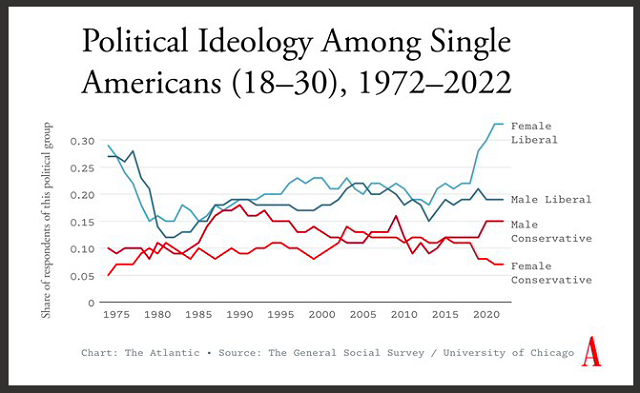Highlights
- The ideological divide between the sexes is growing. Post This
- Young single men have been moving to the right, even as their female peers have been moving even further left. Post This
- About 2/3s of liberal and conservative singles would be more likely to “swipe left” and reject a potential match who did not share their politics. Post This
Marriage rates in America are falling fast: Many men and women are marrying later, and more and more people. are never marrying at all. Marriage is in retreat for a host of reasons, but one overlooked cause is the rising difficulty many young people have finding a partner who meets all of their requirements—emotional, physical, financial, and political. That last requirement has only become more important over time, with fewer Americans willing to date or marry across the aisle.
Dating apps and websites report a growing share of users setting political criteria for matches. The Survey Center on American Life, a project of the American Enterprise Institute, recently found that about two-thirds of liberal and conservative singles would be more likely to “swipe left” and reject a potential match who did not share their politics.
This bodes ill for the future of marriage—given that growing numbers of young men and women find themselves on different sides of America’s deepening political divide. (We base our following analysis on the fact that most young adults who marry will do so with a different-sex partner—according to Census Bureau data, heterosexual marriages accounted for about 98 percent of weddings of people under 35 in 2021.)
The nonpartisan General Social Survey, run out of NORC at the University of Chicago, has been collecting data on young people’s political attitudes since the early 1970s. We’ve found that focusing on singles ages 18 to 30 and pooling data across five-year intervals is a useful way to ensure a large enough sample to track accurately how attitudes in early adulthood have shifted over time. The figure below shows the share of young singles (18–30) in the survey who identified as distinctly liberal or conservative (excluding respondents in the middle who answered as “slightly liberal,” “slightly conservative,” or “moderate, middle of the road”).

The most striking aspect of these trends is that the past decade has seen the sexes polarizing along ideological and political lines, a pattern that coincides with the rise of social media and the post-Trump political landscape. Young single men have been moving to the right, even as their female peers have been moving even further left. About 10 percent of such men were conservative in the early 1980s, but that share has now risen to about 15 percent (while the proportion of single liberal young men has held steady at about 18 percent in recent years).
Continue reading at The Atlantic . . . .










